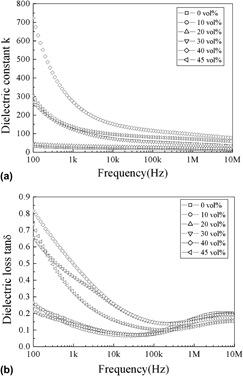Crossref Citations
This article has been cited by the following publications. This list is generated based on data provided by
Crossref.
Lai, Maobai
Yu, Shuhui
Sun, Rong
Zeng, Xiaoliang
Luo, Suibin
and
Wong, Ching-Ping
2013.
Effects and mechanism of graft modification on the dielectric performance of polymer–matrix composites.
Composites Science and Technology,
Vol. 89,
Issue. ,
p.
127.
Yu, Ke
Niu, Yujuan
Bai, Yuanyuan
Zhou, Yongcun
and
Wang, Hong
2013.
Poly(vinylidene fluoride) polymer based nanocomposites with significantly reduced energy loss by filling with core-shell structured BaTiO3/SiO2 nanoparticles.
Applied Physics Letters,
Vol. 102,
Issue. 10,
Chen, Qiuting
Yu, Shuhui
Sun, Rong
and
Xie, Shenghui
2013.
Preparation and dielectric properties of BaTiO<inf>3</inf>@PANI filled PVDF composites.
p.
351.
Luo, Suibin
Yu, Shuhui
Sun, Rong
and
Wong, Ching-Ping
2014.
Nano Ag-Deposited BaTiO3 Hybrid Particles as Fillers for Polymeric Dielectric Composites: Toward High Dielectric Constant and Suppressed Loss.
ACS Applied Materials & Interfaces,
Vol. 6,
Issue. 1,
p.
176.
Luo, Suibin
Yu, Shuhui
Fang, Fang
Lai, Maobai
Sun, Rong
and
Wong, Ching-Ping
2014.
Critical interparticle distance for the remarkably enhanced dielectric constant of BaTiO3-Ag hybrids filled polyvinylidene fluoride composites.
Applied Physics Letters,
Vol. 104,
Issue. 25,
Aepuru, Radhamanohar
and
Panda, H. S.
2014.
Adsorption of Charge Carriers on Radial Zinc Oxide and the Study of Their Stability and Dielectric Behavior in Poly(vinylidene fluoride).
The Journal of Physical Chemistry C,
Vol. 118,
Issue. 33,
p.
18868.
Liang, Xianwen
Zhao, Tao
Hu, Yougen
and
Sun, Rong
2014.
Dielectric properties of silver nanowires-filled polyvinylidene fluoride composite with low percolation threshold.
Journal of Nanoparticle Research,
Vol. 16,
Issue. 9,
Fang, Fang
Yang, Wenhu
Yu, Shuhui
Luo, Suibin
and
Sun, Rong
2014.
Mechanism of high dielectric performance of polymer composites induced by BaTiO3-supporting Ag hybrid fillers.
Applied Physics Letters,
Vol. 104,
Issue. 13,
Zhang, Zhenchong
Gu, Yizhuo
Wang, Shaokai
Li, Min
Bi, Jiayu
and
Zhang, Zuoguang
2015.
Enhancement of dielectric and electrical properties in BT/SiC/PVDF three-phase composite through microstructure tailoring.
Composites Part A: Applied Science and Manufacturing,
Vol. 74,
Issue. ,
p.
88.
Liu, Z. D.
Feng, Y.
and
Li, W. L.
2015.
High dielectric constant and low loss of polymeric dielectric composites filled by carbon nanotubes adhering BaTiO3 hybrid particles.
RSC Advances,
Vol. 5,
Issue. 37,
p.
29017.
Wang, Teng
Zhang, Xianhong
Chen, Dong
Ma, Yuhong
Wang, Li
Zhao, Changwen
and
Yang, Wantai
2015.
Preparation of a hybrid core–shell structured BaTiO 3 @PEDOT nanocomposite and its applications in dielectric and electrode materials.
Applied Surface Science,
Vol. 356,
Issue. ,
p.
232.
Xiao, Xingrong
Yang, Hui
Xu, Nuoxin
Hu, Liang
and
Zhang, Qilong
2015.
High performance of P(VDF-HFP)/Ag@TiO2 hybrid films with enhanced dielectric permittivity and low dielectric loss.
RSC Advances,
Vol. 5,
Issue. 97,
p.
79342.
Luo, Suibin
Yu, Shuhui
Fang, Fang
Lai, Maobai
Sun, Rong
and
Wong, Ching-Ping
2015.
Investigating the mechanism of catalytic reduction of silver nitrate on the surface of barium titanate at room temperature: oxygen vacancies play a key role.
RSC Advances,
Vol. 5,
Issue. 5,
p.
3377.
Zhang, Liang
Gao, Ranran
Hu, Penghao
and
Dang, Zhi-Min
2016.
Preparation and dielectric properties of polymer composites incorporated with polydopamine@AgNPs core–satellite particles.
RSC Advances,
Vol. 6,
Issue. 41,
p.
34529.
Quinsaat, Jose Enrico Q.
Nüesch, Frank A.
Hofmann, Heinrich
and
Opris, Dorina M.
2016.
Hydrophobization of silver nanoparticles through surface-initiated atom transfer radical polymerization.
RSC Advances,
Vol. 6,
Issue. 50,
p.
44254.
Xiao, Xingrong
Xu, Nuoxin
Jiang, Yongchang
Zhang, Qilong
Yu, Enjie
and
Yang, Hui
2016.
TiO2@Ag/P (VDF-HFP) composite with enhanced dielectric permittivity and rather low dielectric loss.
RSC Advances,
Vol. 6,
Issue. 73,
p.
69580.
Shen, Yanbin
Luo, Suibin
Yu, Shuhui
Sun, Rong
and
Wong, C. P.
2016.
Oxidation resistant core-shell Cu@SiO<inf>2</inf> nanowires for composites with high dielectric performance.
p.
361.
Zhang, Zhenchong
Gu, Yizhuo
Bi, Jiayu
Wang, Shaokai
Li, Min
and
Zhang, Zuoguang
2016.
Tunable BT@SiO2 core@shell filler reinforced polymer composite with high breakdown strength and release energy density.
Composites Part A: Applied Science and Manufacturing,
Vol. 85,
Issue. ,
p.
172.
Wee, Sung-Bok
An, Gye Seok
Han, Jin Soon
Oh, Hyeon-Cheol
and
Choi, Sung-Churl
2016.
Co-dispersion behavior and interactions of nano-ZrB2 and nano-SiC in a non-aqueous solvent.
Ceramics International,
Vol. 42,
Issue. 4,
p.
4658.
Wang, Xin
and
Li, Zewei
2017.
Dielectric properties of CB@TiO2/BaTiO3/epoxy composites.
Journal of Materials Science: Materials in Electronics,
Vol. 28,
Issue. 8,
p.
6071.



